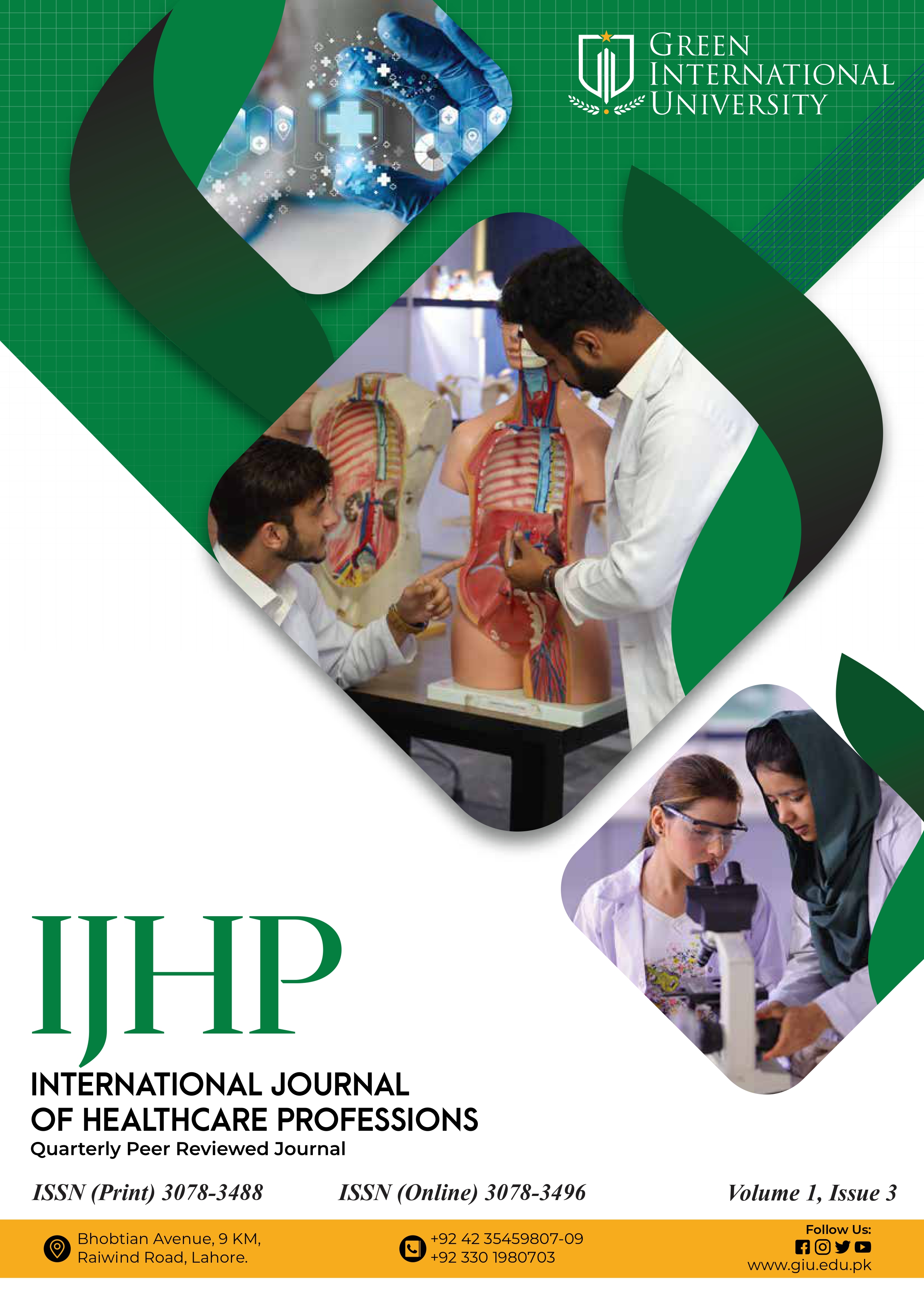Sonographic Features of Urinary Tract Infection in Both Gender Of Various Age Groups
DOI:
https://doi.org/10.71395/ijhp.1.3.2024.31-36Abstract
Background and Objectives: One of the most prevalent illnesses that people might get is urinary tract infections. primarily elderly people and women. Age and gender are two of the risk factors for acute UTIs, and clinical criteria are the main basis for diagnosis. However, ultrasonography is frequently required as part of the therapy workup to assess complex infections, chronic presentations, and contributing or causative variables. Clinical therapy, including aggressive and emergent therapies, is guided by a proper understanding of the most pertinent sonographic characteristics in urinary tract infections, which also give pertinent differential diagnosis.
METHODOLOGY: The current study is a mere descriptive research which has been reviewed and approved by the ethical committee of the University of Lahore, Pakistan. Data was collected from Shalimar Hospital Lahore. Under this group, 136 adults had positive UTI laboratory findings and had abdominal ultrasound. Patients with
abnormal urinary tract disease or immunocompromised illness were not included. All data were done in Excel while data analyses were done in SPSS version 21.
RESULTS: This study collected data from 136 patients, with a minimum age of 14 years and a maximum age of 44 years. Of these, 48 (35.3%) were female and 88 (64.7%) were male. All patients had normal Blood perfusion of the right and left kidney. Urinary bladder echoes found in37 (27.2%)in which 08 patients of 14 to 21(40%) years had Urinary bladder echoes, 24 patients of 22 to 29 (25.5%) years had urinary bladder echoes, 3 patients of 30 to 37 (17.6%) years had urinary bladder echoes, 02 patients of 38 to 44(40%) years had urinary bladder echoes.
CONCLUSION: Age and gender contribute to UTI occurrence with male individuals being more susceptible to the condition. Sep 6 2011 Bladder echoes are noticed in 14-21 years and 38-44 years and pyelonephritis in adults. USG is pragmatic in the formation of UTI images..
References
Schmiemann G, Kranz J, Mandraka F, Schubert S, Wagenlehner F, Gágyor I. The diagnosis, treatment, and prevention of recurrent urinary tract infections. Deutsches Ärzteblatt International. 2024;121(11):373.
Lindén M, Rosenblad T, Rosenborg K, Hansson S, Brandström P. Infant urinary tract infection in Sweden—A national study of current diagnostic
procedures, imaging and treatment. Pediatric Nephrology. 2024;39(11):3251-62.
Sula I, Alreshidi MA, Alnasr N, Hassaneen AM, Saquib N. Urinary tract infections in the Kingdom of Saudi Arabia, a review. Microorganisms. 2023;11(4):952.
Harb A, Yassine V, Ghssein G, Salami A, Fakih H. Prevalence and clinical significance of urinary tract infection among neonates presenting with unexplained hyperbilirubinemia in Lebanon: A retrospective study. Infection & Chemotherapy. 2023;55(2):194.
Saddari A, Benhamza N, Dalli M, Ezrari S, Benaissa E, Lahlou YB, et al. Urinary tract infections older adults at Mohammed VI University Hospital of Oujda: case series. Annals of Medicine and Surgery. 2023;85(5):1408-12.
Huang L, Huang C, Yan Y, Sun L, Li H. Urinary tract infection etiological profiles and antibiotic resistance patterns varied among different age
categories: a retrospective study from a tertiary general hospital during a 12-year period. Frontiers in microbiology. 2022;12:81-85.
Komagamine J, Yabuki T, Noritomi D, Okabe T. Prevalence of and factors associated with atypical presentation in bacteremic urinary tract infection. Scientific reports. 2022;12(1):51-55.
Swamy SNN, Jakanur RK, Sangeetha SR. Significance of C-reactive protein levels in categorizing upper and lower urinary tract infection in adult patients. Cureus. 2022;14(6):12-15.
Goździkiewicz N, Zwolińska D, Polak-Jonkisz D. The use of artificial intelligence algorithms in the diagnosis of urinary tract infections—a literature review. Journal of Clinical Medicine. 2022;11(10):2734.
Gozdzikiewicz N. Zwoli nska, D.; Polak-Jonkisz, D. The Use of Artificial Intelligence Algorithms in the Diagnosis of Urinary Tract Infections—A
Literature Review. Pediatric and Adolescent Nephrology Facing the Future. 2022;11:265-68.
Jeng S-L, Huang Z-J, Yang D-C, Teng C-H, Wang M-C. Machine learning to predict the development of recurrent urinary tract infection related to
single uropathogen, Escherichia coli. Scientific reports. 2022;12(1):17216.
Sako A, Yasunaga H, Matsui H, Fushimi K, Yanai H, Gu Y, et al. Hospitalization for urinary tract infections in Japan, 2010–2015: a retrospective study using a national inpatient database. BMC Infectious Diseases. 2021;21:1-10.
Bilgin H, Yalinbas EE, Elifoglu I, Atlanoglu S. Maternal urinary tract infection: is it associated with neonatal urinary tract infection? Journal of
Family & Reproductive Health. 2021;15(1):8-11.
Vachvanichsanong P, McNeil E, Dissaneewate P. Extended-spectrum beta-lactamase Escherichia coli and Klebsiella pneumoniae urinary tract
infections. Epidemiology & Infection. 2021;149:12-15.
Isert S, Müller D, Thumfart J. Factors associated with the development of chronic kidney disease in children with congenital anomalies of the kidney and urinary tract. Frontiers in Pediatrics. 2020;8:298-300.
Oliveira EA, Mak RH. Urinary tract infection in pediatrics: an overview. Jornal de pediatria. 2020;96:65-79.
Shaki D, Hodik G, Elamour S, Nassar R, Kristal E, Leibovitz R, et al. Urinary tract infections in children< 2 years of age hospitalized in a tertiary medical center in Southern Israel: epidemiologic, imaging, and microbiologic characteristics of first episode in life. European Journal of Clinical Microbiology & Infectious Diseases. 2020;39:955-63.
Kamei J, Yamamoto S. Complicated urinary tract infections with diabetes mellitus. Journal of Infection and Chemotherapy. 2021;27(8):1131-6.
Amoori P, Valavi E, Fathi M, Sharhani A, Izadi F. Comparison of Serum Zinc Levels Between Children With Febrile Urinary Tract Infection and
Healthy Children. Jundishapur Journal of Health Sciences. 2021;13(3).
Muntean C, Săsăran M. Vitamin D status and its role in first-time and recurrent urinary tract infections in children: a case-control study. Children.2021;8(5):419.
Downloads
Published
Issue
Section
License
Copyright (c) 2025 International Journal of Healthcare Professions

This work is licensed under a Creative Commons Attribution 4.0 International License.
This is an open-access journal and all the published articles / items are distributed under the terms of the Creative Commons Attribution License, which permits unrestricted use, distribution, and reproduction in any medium, provided the original author and source are credited. For comments ijhp@giu.edu.pk






